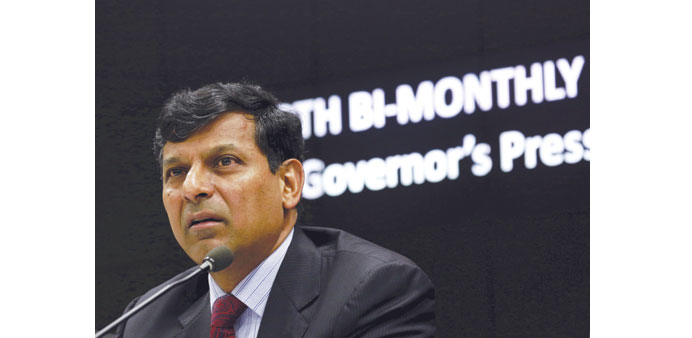Reserve Bank of India governor Raghuram Rajan speaks at a news conference after the bi-monthly monetary policy review in Mumbai yesterday.
Reserve Bank of India cuts repo rate by 50 bps to 6.75%; cites low inflation, weak economy, Fed rate hike delay; 10-year bond yield drops 17 bps, shares rally; RBI cut its growth forecast for the fiscal year to 7.4% from 7.6% previously; sets a new inflation target of around 5% by March 2017
Reuters
Mumbai
The Reserve Bank of India cut its policy interest rate to a 4-1/2-year low of 6.75% yesterday, in a bigger-than-expected move that, with inflation running at record lows, could help turn around an economy that has been slowing down.
“I don’t think we have been excessively aggressive,” RBI governor Raghuram Rajan told a news conference, explaining that the RBI had “front-loaded” the easing in response to downgrades to expectations for global growth.
“Clearly this was about, given the state of the economy, how can we move forward,” he added, reflecting widespread concern that India’s growth was losing momentum.
The RBI cut its growth forecast for the fiscal year to 7.4% from 7.6% previously, well below the government’s target of 8 to 8.5%, but still faster than China.
The central bank said it expects inflation to rise from August’s record low of 3.66% to 5.8% in January, just below its 6% target.
It also set a new inflation target of around 5% by March 2017, and Rajan said the RBI would strive to keep real interest rates benchmarked to a 1-year Treasury bill rate of between 1.5 and 2%.
At the same time, the RBI announced a slew of measures intended to further open debt and currency markets, signalling confidence in an economy expected to do better than most emerging market peers when US interest rates eventually go up for the first time in nearly a decade.
The measures included increasing the current $30bn limit for foreign investments in government bonds by Rs1.2tn ($18.13bn) by March 2018 in stages, and allowing overseas funds to buy debt issued by Indian states.
But it was the size of the rate cut that excited most comment, with analysts doubting whether there would be further easing, at least for a while, putting the onus on Prime Minister Narendra Modi to overcome resistance in parliament to his reforms. “We think that today’s larger-than-expected rate cut will mark the end of the easing cycle,” Shilan Shah, an economist for Capital Economics in Singapore, commented in an e-mail.
The benchmark 10-year Indian government bond yield dropped as much as 17 bps to 7.56%, its lowest level since mid-July 2013, while share indexes surged more than 1% after initial falls. The rupee was broadly unchanged.
While there had been calls from within Modi’s cabinet for the RBI to cut rates more aggressively, most analysts doubted whether Rajan had succumbed to pressure, even though only one analyst out of 51 polled by Reuters last week had forecast a 50 bps reduction in the policy repo rate.
Forty-five had expected a 25 bps cut, the same magnitude as previous three cuts this year.
Certainly Rajan gave the impression of being his own man when asked whether he felt like Santa Claus during the news conference.
“My name is Raghuram Rajan, and I do what I do,” the governor responded in a remark that flew round social media.
Reducing rates during the monsoon season, running from mid-June through September, is unusual for the RBI. It has tended to be on the defensive against food price pressures after disappointing rains. This is the first cut during that period since the repo rate was adopted as the policy rate in 2004.
Analysts said economic factors probably lay behind the strong move to force banks to lower lending rates faster. While the RBI has reduced official rates by 125 bps since embarking on an easing cycle in January, banks have moved far more slowly.
The latest repo rate reduction, however, was swiftly answered. State Bank of India, the country’s largest commercial bank, lowered its base lending rate by 40 bps to 9.3%.

